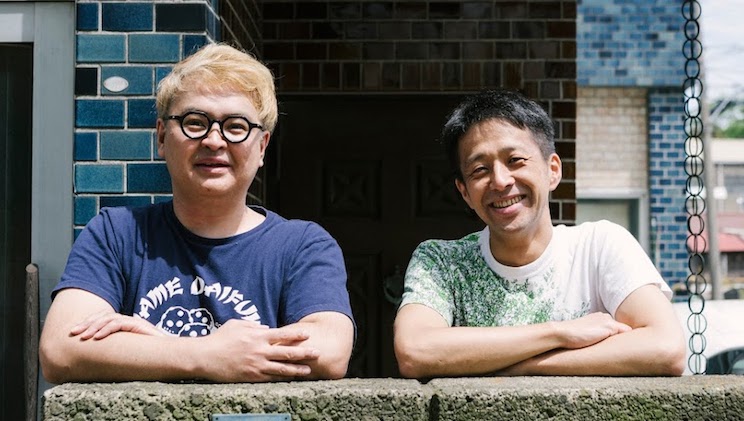Stores in the town change their norens (shop curtains)? Form of new town-building activities realized by old standings and creators.
Stores in the town change their norens (shop curtains)? Form of new town-building activities realized by old standings and creators.

Both Muromachi 1-chome and Honmachi 1-chome in Nihonbashi are towns that are crowded with many roadside stores, although they are situated in a place near large-scale offices and commercial buildings. They really are spots where you can enjoy walking along the streets. In this area, an association called “Muro 1 / Hon 1 Nigiwai no Kai (Association of Bustle)” has been established in recent years with the local stores and companies as the main players for the purpose of making bustle and improving the landscape, and town-building activities are being promoted mainly by local communities. As part of these activities, old standings and companies have collaborated with local creators to hold an event of original norens for a limited time from October 11th. These norens have been created by a combination of female creators, Ms. Misako Saito, the 5th generation head of a wholesaler Marukyu Shouten that deals with dyed products, founded in the Meiji era, and Ms. Ryoko Yamane, an illustrator from Ukai Co., Ltd. This time, we asked them about their production episode and the relationship between the town and the creativity.
A wholesaler that communicates directly with customers in accordance with the change of the times.
―Ms. Saito, you were in charge of making norens for each store. Could you please tell us about Marukyu Shouten first?
Saito: Marukyu Shouten is a wholesaler founded in the 32th year of the Meiji Period that produces a yukata (an informal cotton kimono) and hand towels using a dyeing technique called “chusen.” I am the fifth generation head of the store, but I lived in Chiba Prefecture when I was a child, so the office in Nihonbashi was nothing but my father's workplace and I was looking at it, somewhat, as something alien to me. I majored in the Department of Japanese Painting at the Tokyo University of the Arts, but it was not because I was thinking about the family business, but because I liked Japanese painting and purely I was studying there as I wanted to learn how to paint.
―Are there any triggers that you became involved in the family business?
Saito: Around the time I completed my grad school studies after I graduated from the university, my father murmured in a tired manner, “I wonder if I should be closing the store." I hadn't been much conscious of it until then, but suddenly I felt lonely when I thought that the yukatas and hand towels I had been familiar with since I was a child might disappear. So, I started to think seriously about helping the family business and started working at Marukyu Shouten with my husband. It’s been five years now.

Ms. Misako Saito, the fifth generation head of Marukyu Shouten
―Do you have anything you are particular about while working in Marukyu Shouten, Ms. Saito?
Saito: It's a traditional and highly specialized job, but I'm not only following the tradition, and I wish to try to challenge new things in my own way more and more. For example, the other day, we held a summer vacation workshop for elementary school students. It was an event to make a hand towel by drawing a picture with the theme of summer vegetables to make it into a pattern, and dye it. Look at these wonderful works created by them. Children really made it with their ability combined together.

Hand towels made by elementary school students at the workshop
―It's a very nice effort! But why did the wholesaler Marukyu Shouten have an event for the general public?
Saito: Our main functions as a wholesaler had been working mainly for correlation between factories and retail stores for a long time, but now that SNS has penetrated to our daily life, we can check the direct reaction of our customers using it. As we experienced communication with them, we have learned to desire creating more opportunities to get in touch with customers. So, we are now doing co-creation event with customers such as setting up a vendor in local festivals or soliciting designs to make yukatas by crowdfunding, in addition to doing workshops. In the future opportunities also, we would like to continue our efforts that go beyond the frame of traditional wholesalers.
Think about “what to dispatch” through design.
―Could you tell us about your career up until now and activities at Ukai?
Yamane: I also liked drawing, and when I graduated from high school, I moved to Tokyo to study at Kuwasawa Design School. One of the instructors in my third year there is the current president of “Ukai” which I work for. He was such a powerful man and kind of different, in short, an interesting person (laughs). So I thought, “What kind of future will I have if I go after him?” And I joined the company as I was asked by the president. When I joined Ukai, it was a photography firm, but now I am mainly in charge of illustration work and graphic design in the focused activities of the company for strengthening the creative field.

Ms. Ryoko Yamane, Illustrator at Ukai
―When we look at your work so far, we feel that it is beyond your occupational field as an illustrator, isn’t it? You are doing product production and event planning.
Yamane: Although our duties are centered on client work, these days, we are also strengthening ourselves “to send messages on our own.” For example, recently I was in charge of making a package of granola using puffed cereal for a company in Shimane Prefecture, but as I worked on it, I felt that I could expand the project a little further. So, the other day, I made proposals as far as about visual creation around the publicity and exhibition sales. Because I sympathized with the producer's ideas, such as a strong commitment to products, developing just visual design was not enough to me, and I wanted it to be developed into something with higher publicity through designs.
I always wish to have this posture that allows going beyond just drawing illustrations. In this noren designing as well, I was conscious of thinking about what we would like to communicate and what kind of communication can be realized, rather than just presenting as visual design.
Role division to maximize the value of the store.
―Now, we would like to ask you about this noren event. Could you tell us how this event came about?
Ms. Yamane: Well, there was an event last year, in the first place, for the production of norens (https://nihonbashi-beta.jp/2018/noren/) by the collaboration of the companies in Nihonbashi and creators,called the “Exhibition on Future Norens,” and a local store owner who found the event thought that it might be possible for his store to do the same event too. I hear that’s how it started.
He thought, if he was going to do it, “Why not do it with other stores together, not doing by just one store? Developing it in multiple stores will surely lead to the bustle of the area. They should definitely work with local creators,” and it ended up offering this event to Ms. Saito and me. A town-building organization called “Muro 1 / Hon 1 Nigiwai no Kai,” which is active with volunteers from Muromachi 1-chome and Honmachi 1-chome in Nihonbashi, was the main body, and the twelve stores and companies that comprise the “Nigiwai no Kai” have taken parts in this.
―How did you proceed with the production of the norens?
Ms. Yamane: First of all, we interviewed twelve stores and companies one by one with the secretariat members of the Nigiwai no Kai. We not only asked what kind of business each store or company is doing, but also tried to ask them as deeply as possible about intangible matters such as their vision, the personality of the person who explained to us, and what they value. Based on those stories, I drew idea sketches for each, and Ms. Saito formulated them into actual noren design.
Saito: Those idea sketches were so cute anyway. She must have come up with various ideas during the hearing. I knew she enjoyed drawing those sketches, and it was a lot of fun to choose a motif for the noren from them. For example, I had a crush on the illustration of “boiled octopus” in the sketch of a bento restaurant called “ Nihonbashi Benmatsu-Souhonten .” I thought instantly that I would definitely put it in the noren (laughs). In order to express the fun of bento, I tried inlaying like this.
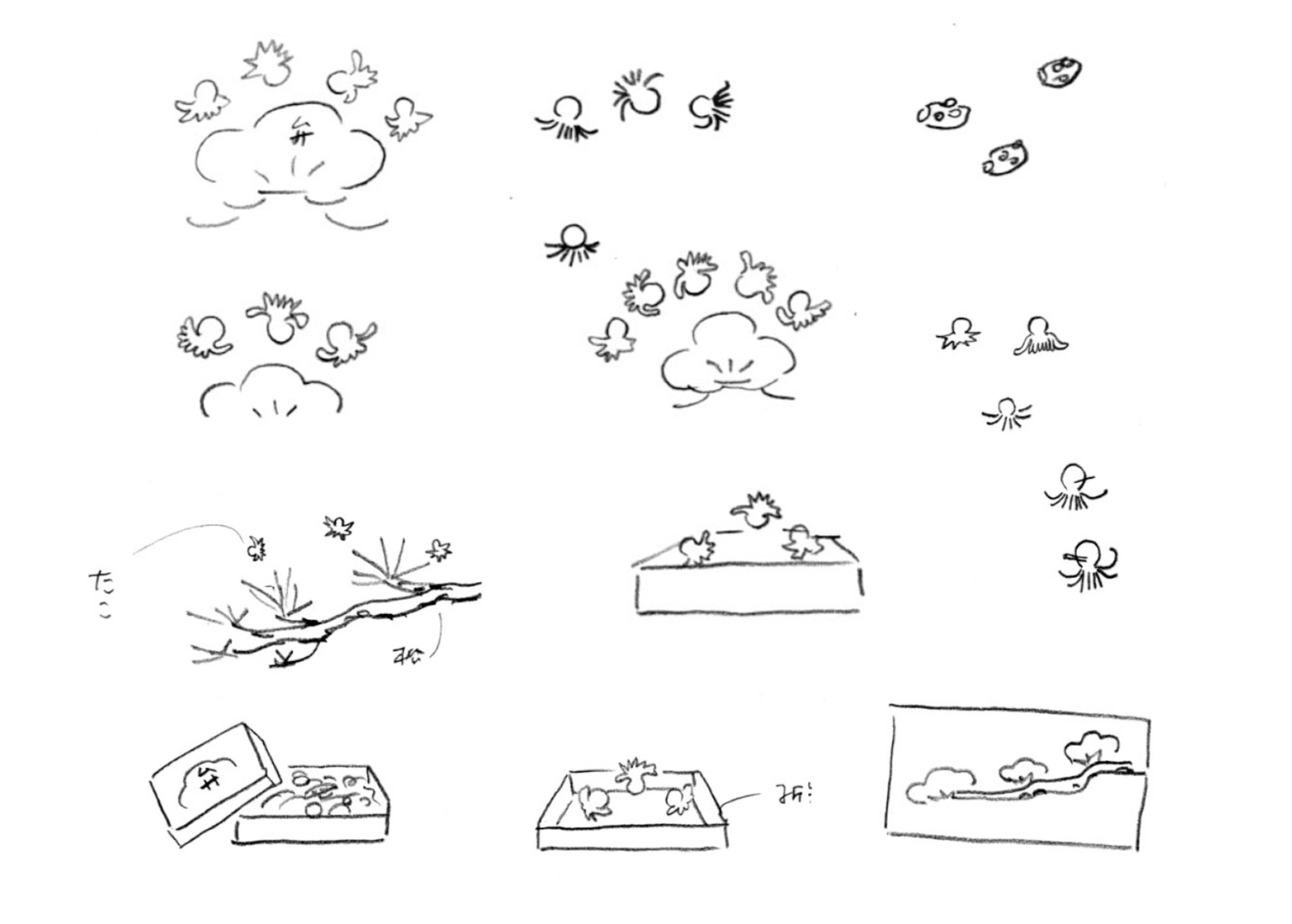
A sketch of Ms. Yamane, an original noren design of “Nihonbashi Benmatsu-Souhonten”
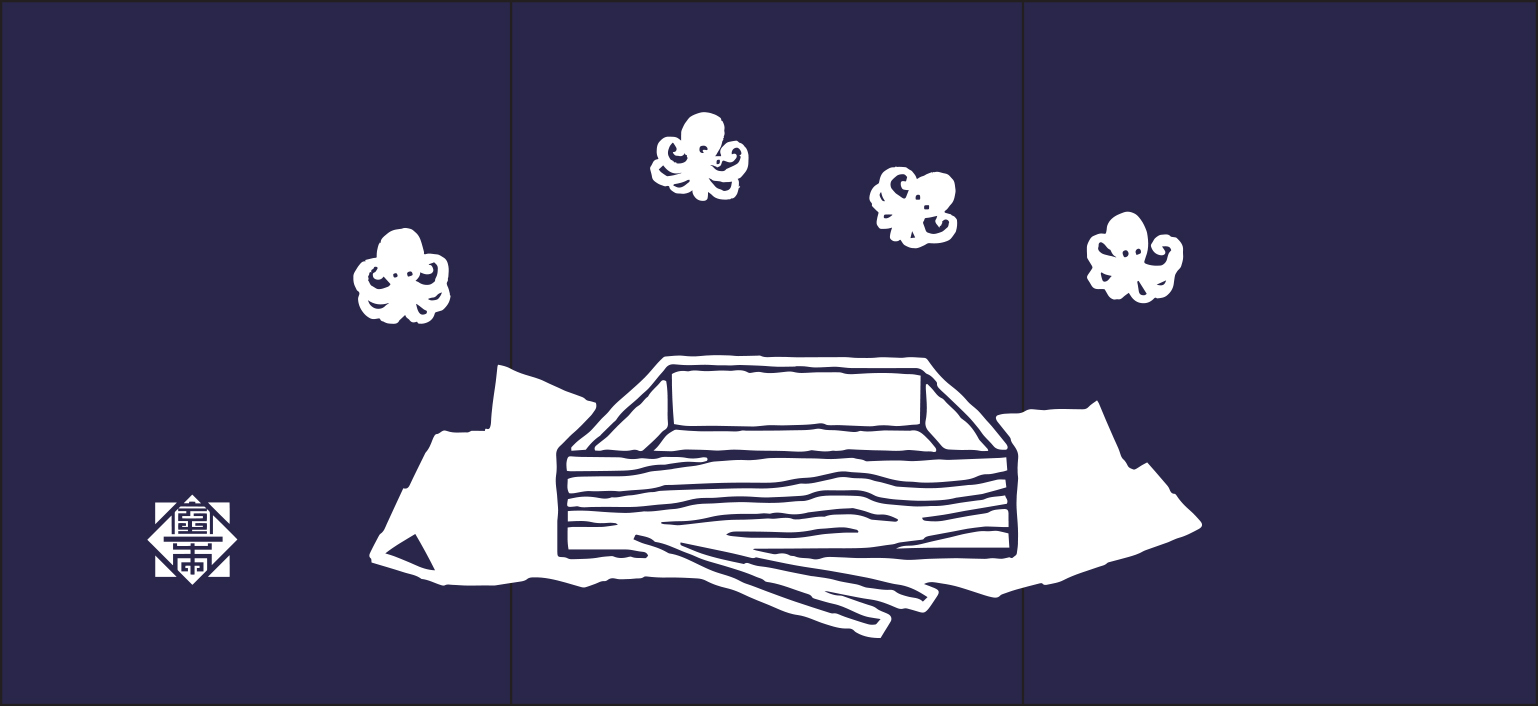
The noren design of “Nihonbashi Benmatsu-Souhonten”
Yamane: Benmatsu is a store that normally uses wooden boxes as bento boxes, but in order to make them fancier ones, we added a wrapping paper to them during our attempt. In this way, we brushed up our ideas little by little while consulting with everyone. The balance when twelve designs are positioned is also important, so we repeated redrawing of the designs and minor adjustments again and again to give a sense of unity as well as originality.
―Are there any parts that you have taken particular care of in the duties allotted to each of you?
Yamane: The thing I valued most in thinking about motifs was to “extract a thing that conveys personality so that signs of human beings do not disappear.” The case in Shigeno Sushi is exactly like that. Not to mention the deliciousness of the sushi, but what ultimately left the impression was the “person” who made the sushi. That's why I tried using a “hand” to make sushi as a motif. I really think it’s wonderful if the store's idea of making sushi with all the heart is conveyed to people from this motif.

A noren design of “Shigeno Sushi”
Saito: I placed importance on selecting motifs that show the value and originality of the store just by looking at it, while being conscious of the role of “advertisement,” which is the original role of noren. This time, I deliberately did not accompany the designer Ms. Yamane to the stores for hearing because I valued the sensibility of her, and made the final design with the consciousness of “appearance of noren” By having a perspective as a third party, I think I was able to create them with the feeling of people who have not known the store before and seen the noren for the first time. I think that this role division worked well.
-The mark put in the lower left, which is used uniformly to all the norens, was created by Ms. Saito, right?
Saito: Yes, I made this mark being fussy about details. In an attempt to express the meaning of the store being “more and more prosperous,” as the Japanese pronunciation of “Han-jo” can be read as “half” and “prosperity,” so, after drawing two square wooden measuring cups (masu) in a compiled manner, I put a letter “1” taken from “Muro 1 / Hon 1” to split it. In this way, each masu stands for “prosperous,” and with two of them, it is read “masu masu” which means “more and more.” It's a kind of pun called “Hanji-eh” form the culture of the Edo period.
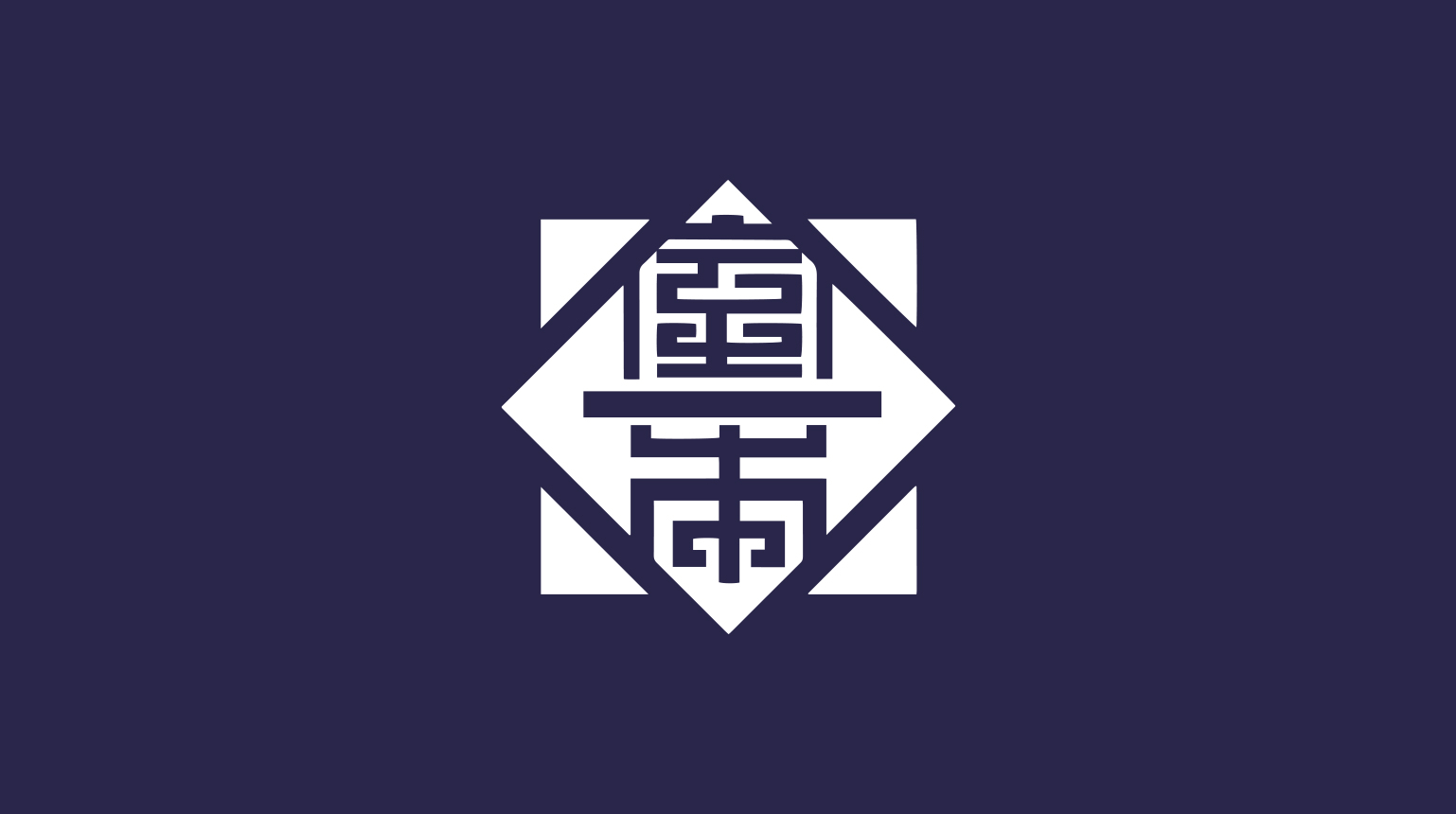
Unified mark for this noren project
Creative style as it ought to be in town-building activities.
―From your story, I feel that both of you are thinking deeply about each store. How has the reaction been from the owners?
Saito: Because there were a lot of old standing and traditional stores, I was scary, “Would they understand my intention at all? How will they feel about it? Isn’t this a bit too cute for them?” My heart was really throbbing with the excitement when I made proposal to them. In fact, when I first showed them to the store owners in the form of sketches, the venue was full of the atmosphere of "??" They don't have any experience or knowledge of design, so I guess they couldn't provide even any comments, thinking "What's going on with this ...?" However, the next time I showed the design that would actually be norens, they went crazy about them. “Which is mine?!” asked every store owners asked filled with joy and excitement. I just think that we should have taken a video of that scene (laughs).

Yamane: That was quite a relieved moment, indeed. What I admire about these owners is that they had this stance according which they desired to respect the creator’s thoughts, thinking that they can’t get out of their conventional way of thinking if they expressed too much of their opinions. So, almost no modifications were made to the designs I proposed. Everyone was interested in this project and the discussion went on very positively. A common image of “old standing storekeeper is stubborn and strict” was blown away.
However, I think that the real value of the project can only be accepted after the noren is hoisted on the each store. I'm looking forward to seeing how the store owners will react then.
―Maybe, creativity of a new noren design is leading to new expressions of the stores and companies.
Yamane: Yes, I think it’s wonderful if that’s the case. We would be very happy if people could rediscover the value of the store seen from the outside as we did express the store in the form of a noren design this time in spite of the fact we didn't know anything about the store or company before.
I think words (or notions) such as “creativity” or “creators” aren't so familiar with ordinary people on a daily basis, and local people might feel a little far from these words. However, when a concrete “thing” is made the distance will be shortened, won’t it? The response of the store owners that changed dramatically when they saw the actual design of noren. We think that was the moment which applies to this case. It’s about creating an understanding of “Oh, that's what it is.” I felt that it would be possible to get rid of the barriers against creativity by making the output that is visible.
As I also wanted them to feel the power of design in this type of opportunities, so I'm glad I worked hard with Ms. Saito to achieve high-quality output.
Saito: Through a noren, a common and important icon for a store in the town, discussions emerged naturally across positions or beyond fields each store is in, which eventually lead to the same direction and created a sense of unity. It may be said that it is a type of town-building activities.
I think that one of the purposes of town-building activities is to make the town attractive and have many people visit it, but on the other hand, it is equally important to create motivation for people inside the community and create a new connection. In that sense, the fact that we were able to reconstruct the appeal of the town and stores from an outside perspective this time was a very positive thing and I thought that it was a wonderful approach to cheer up the actors of the town. The word “town building” has a somewhat heavy impression, but if creativity mediates it can be a trigger to discuss it in a more lightheartedly manner, and it may function as one of methods of town building.
It’s nice if norens can be a trigger for people to meet the town.
―Do you have anything in mind or any ideas that you want to challenge using a town as a base?
Yamane: “Ukai” which I work for has an office in Oodenma-cho. Although I had friendly feeling toward the town as a workplace, I realized that I did not know its charm until now. The reason why I say this is, while talking to a lot of local people after this project, I discovered, for the first time that “persons in Nihonbashi may be hilarious…” (laughs). I may have unconsciously felt awkward to the traditional Nihonbashi town. I thought what a waste it was, not knowing such interesting people. I also wanted to tell more about the fun of this town to my colleagues in the industry. Now that it is a town where professional people with various skills get gather, if a system in which creators' skills and old standings can be collaborated is set up, I think that something wonderful and interesting synergies will be created.
Saito: I was delighted to see the norens I worked on actually hoisted, which means that I was able to be of some help to them. Also the fact gave me a confidence in exploring the next form of wholesale. Conventionally, the main focus of our business was to make hand towels for certain industries such as classical Japanese dancing, so it cannot be said that we were so much rooted in the town. Now with the various encounters through this project, I renewed my desire to do more work related to the town.
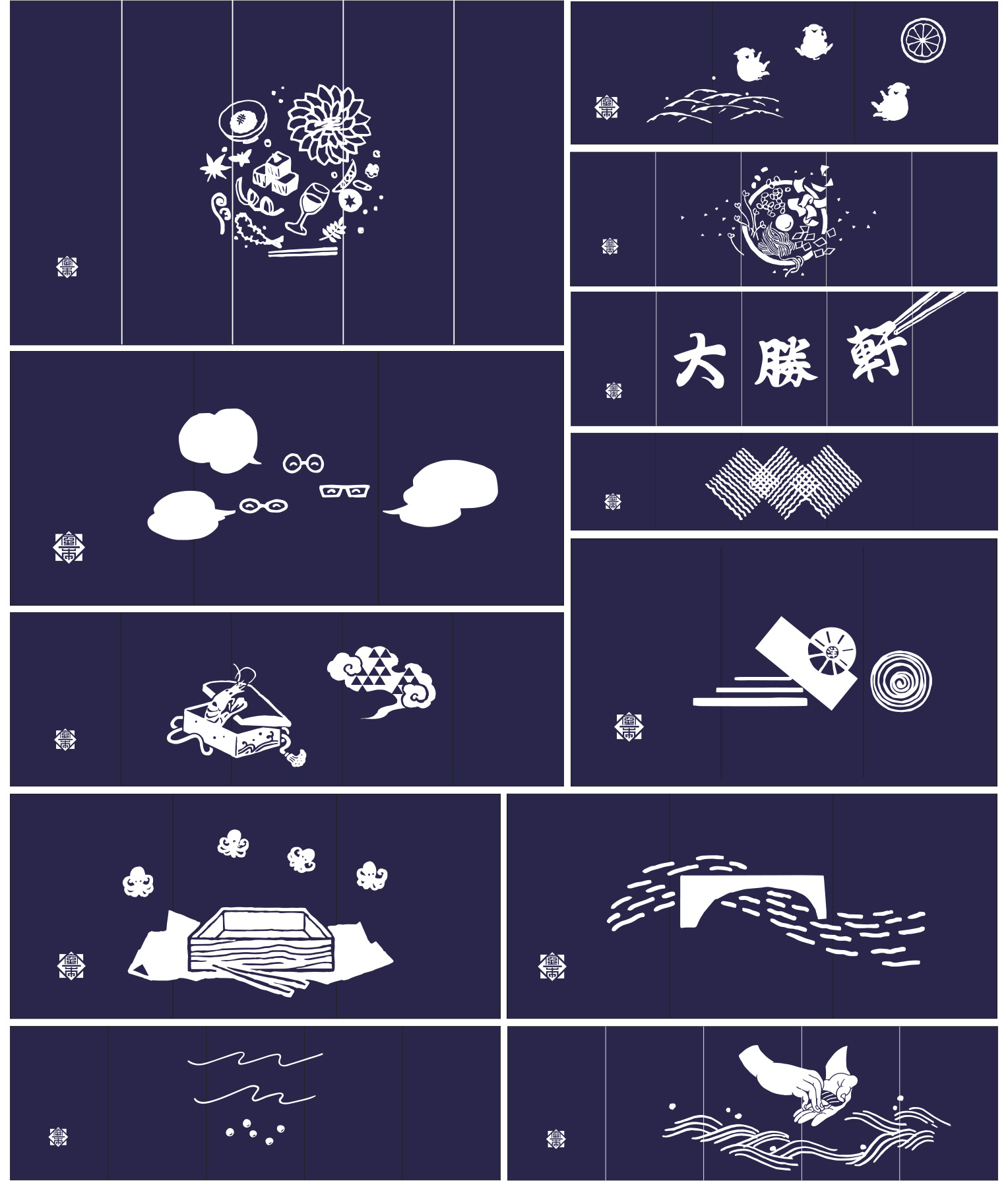
List of noren designs in this project
―The noren project this time may be an interface for visitors to meet stores and companies. Who do you want to see them?
Saito: After all, I want new customers to see them. I would be delighted if the norens trigger people to think, “Let's try this store” or “Give it a try on this food.” I will be happy if those groups of customers who had not entered the stores come in touch with the values of the stores and towns. It might be interesting to walk around the streets while enjoying the different designs of twelve stores which are hoisting norens.
Interview and Article: Minako Ushida (Konel) / Photo: Daisuke Okamura
"Meguru Noren Exhibition (an exhibition for encountering and cherishing Norens)"
Production of norens to each store and company shall be made from October 11th (Fri) to November 4th (Mon).
.jpg)


